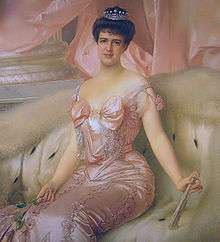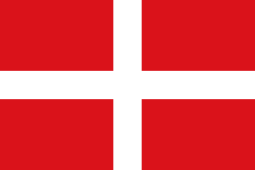Amélie of Orléans
| Amélie of Orléans | |||||
|---|---|---|---|---|---|
 Queen Amélie before 1908 | |||||
| Queen consort of Portugal | |||||
| Tenure | 19 October 1889 – 1 February 1908 | ||||
| Born |
28 September 1865 Twickenham, London, England, UK | ||||
| Died |
25 October 1951 (aged 86) Le Chesnay, France | ||||
| Burial | Royal Pantheon of the Braganza Dynasty, Lisbon, Portugal | ||||
| Spouse | Carlos I of Portugal | ||||
| Issue |
Luís Filipe, Prince Royal Manuel II of Portugal | ||||
| |||||
| House | Orléans | ||||
| Father | Prince Philippe, Count of Paris | ||||
| Mother | Princess Marie Isabelle d'Orléans | ||||
| Religion | Roman Catholicism | ||||
| Signature |
| ||||
Princess Amélie of Orléans (28 September 1865 – 25 October 1951) was the last Queen consort of Portugal, known to her husband's subjects as "Maria Amélia de Orleães". As the eldest daughter of Prince Philippe, Count of Paris, and his wife, Princess Marie Isabelle d'Orléans, she was a "Princess of Orléans" by birth.
Family
Amélie's paternal grandparents were Prince Ferdinand Philippe, Duke of Orléans, and Duchess Helena of Mecklenburg-Schwerin. Her maternal grandparents were Prince Antoine, Duke of Montpensier, and the Infanta Luisa Fernanda of Spain.
The Dukes of Orléans and Montpensier were siblings, both sons of Louis-Philippe I, King of the French, and Maria Amalia of the Two Sicilies.
Marriage and Issue
On 22 May 1886, Amélie married Carlos, Prince Royal of Portugal. He was the eldest son of King Luís I of Portugal and Maria Pia of Savoy. He was at the time the heir apparent to the throne. The bride was almost twenty-one years old and the groom about twenty-three. The marriage had been arranged by their families after several attempts to arrange a marriage for her with a member of the Austrian or Spanish dynasties. At first, the marriage was not popular and Queen Maria Pia was expecting to marry Carlos to the Archduchess Marie Valerie of Austria, Princess Mathilde of Saxony, Princess Viktoria of Prussia or Princess Victoria of Wales. However, Amélie and Carlos came to live quite harmoniously with each other.
They had three children:
- Luís Filipe, Duke of Braganza (21 March 1887 – 1 February 1908).
- Infanta Maria Anna of Portugal (born and deceased on 14 December 1887).
- Manuel II of Portugal (15 November 1889 – 2 July 1932).
Queen consort

Amélie played an active role as a queen, and somewhat softened the growing criticism towards the monarchy with her personal popularity, though she did receive some criticism for her expenses. She was active in many social projects, such as the prevention and treatment of tuberculosis and the foundation of charity organisations, sanatoriums and drugstores. She was considered less formal than her mother-in-law Maria Pia, learned Portuguese well and was described as calm and mild. She was interested in literature, opera and theatre, was a diarist and also painted. During the absence of her spouse in 1895, she acted as regent. In 1902, she made a cruise on the Mediterranean Sea that was much criticised for its luxury.
In 1892, Pope Leo XIII gave a Golden Rose to Amélie.
On 19 October 1889, her father-in-law died and Carlos succeeded him on the throne. Amélie became the new Queen consort of Portugal. However her husband became known for his extramarital affairs while the popularity of the Portuguese monarchy started to wane in the face of a bankrupt economy, industrial disturbances, socialist and republican antagonism and press criticism.
Lisbon regicide
On 1 February 1908, the royal family returned from the palace of Vila Viçosa to Lisbon. They travelled in the royal train to Barreiro and from there took a boat to cross the Tagus River. They disembarked at Cais das Colunas in the principal square of downtown Lisbon, the Terreiro do Paço. On their way to the Palace of Necessidades, the carriage carrying Carlos and his family passed through the Rua do Arsenal (Arsenal Street). While crossing the square and turning to the street, several shots were fired from the crowd by at least two men: Alfredo Costa, Manuel Buiça, between many others. The King died immediately, his heir Prince Dom Luís was mortally wounded, and Infante Dom Manuel was hit in the arm, yet Queen Amélie was surprisingly unharmed after trying to defend her youngest son, the new king Manuel II, with the flower bouquet she kept in her hand.

The two assassins were shot on the spot by members of the royal bodyguard and later were recognized as members of the Portuguese Republican Party and of their masonic left-wing organisation Carbonária. About twenty minutes later, Prince Luis Filipe died and the next day, Manuel was acclaimed king of Portugal, the last of the Braganza dynasty.
Manuel II of Portugal was deposed by a military coup, later known as the 5 October 1910 revolution, which resulted in the establishment of the Portuguese First Republic. Queen Amélie left Portugal with the rest of the royal family and went into exile. She lived most of her remaining life in France. During World War II the Portuguese government invited her to return to Portugal, but she declined the offer. She visited Portugal the last time in 1945.
She was the last Queen consort of Portugal, as the monarchy has never been restored.
Titles
- 28 September 1865 – 22 May 1886: Her Royal Highness Princess Amélie of Orléans
- 22 May 1886 – 19 October 1889: Her Royal Highness The Princess Royal of Portugal, Duchess of Braganza
- 19 October 1889 – 1 February 1908: Her Most Faithful Majesty The Queen of Portugal and the Algarves
- 1 February 1908 – 25 October 1951: Her Most Faithful Majesty The Dowager Queen of Portugal and the Algarves
Honours
National dynastic honours
-
.svg.png) House of Braganza: Knight Grand Cross of the Royal Order of the Immaculate Conception of Vila Viçosa[1][2]
House of Braganza: Knight Grand Cross of the Royal Order of the Immaculate Conception of Vila Viçosa[1][2] -
.svg.png) House of Braganza: Knight Grand Cross with Collar of the Royal Order of Christ[3]
House of Braganza: Knight Grand Cross with Collar of the Royal Order of Christ[3] -
.svg.png) House of Braganza: 7th Grand Mistress Dame Grand Cross of the Royal Order of Saint Isabel, Special Class[4]
House of Braganza: 7th Grand Mistress Dame Grand Cross of the Royal Order of Saint Isabel, Special Class[4]
Foreign honours
-
.svg.png) Austrian Imperial and Royal Family: Dame of the Imperial and Royal Order of the Starry Cross, 1st Class[5]
Austrian Imperial and Royal Family: Dame of the Imperial and Royal Order of the Starry Cross, 1st Class[5] -
 Italy
Italy
-
 Sovereign Military Order of Malta: Dame Grand Cross of Obedience of the Sovereign Military Order of Malta
Sovereign Military Order of Malta: Dame Grand Cross of Obedience of the Sovereign Military Order of Malta
-
-
.svg.png) Spanish Royal Family: 867th Dame Grand Cross of the Order of Queen Maria Luisa
Spanish Royal Family: 867th Dame Grand Cross of the Order of Queen Maria Luisa -
 Russian Imperial Family: Dame Grand Cordon of the Imperial Order of Saint Catherine
Russian Imperial Family: Dame Grand Cordon of the Imperial Order of Saint Catherine
Ancestry
References
- ↑ http://41.media.tumblr.com/0a0cd92af4777c6c8235178b9d9032bf/tumblr_nyc2w5BpzG1qzjmo0o1_1280.jpg
- ↑ https://40.media.tumblr.com/tumblr_lzcoakS4e71qcfftgo1_400.jpg
- ↑ http://www.gettyimages.co.uk/detail/news-photo/amelia-of-orleans-queen-of-portugal-late-19th-early-20th-news-photo/463958681
- ↑ https://upload.wikimedia.org/wikipedia/commons/d/d8/Rainha_Amélia.jpg[]
- ↑ https://41.media.tumblr.com/f4fac6df30d34f89544ba99fe571cc82/tumblr_n2pc8aGRNt1rdstngo1_500.jpg
External links
| Wikimedia Commons has media related to Amélie d'Orléans. |
- Marek, Miroslav. "A listing of the House of Orléans". Genealogy.EU.
- Queen Amelia of Portugal
| Amélie of Orléans Cadet branch of the House of Bourbon Born: 28 September 1865 Died: 25 October 1951 | ||
| Portuguese royalty | ||
|---|---|---|
| Preceded by Maria Pia of Savoy |
Queen consort of Portugal 19 October 1889 – 1 February 1908 |
Monarchy abolished |